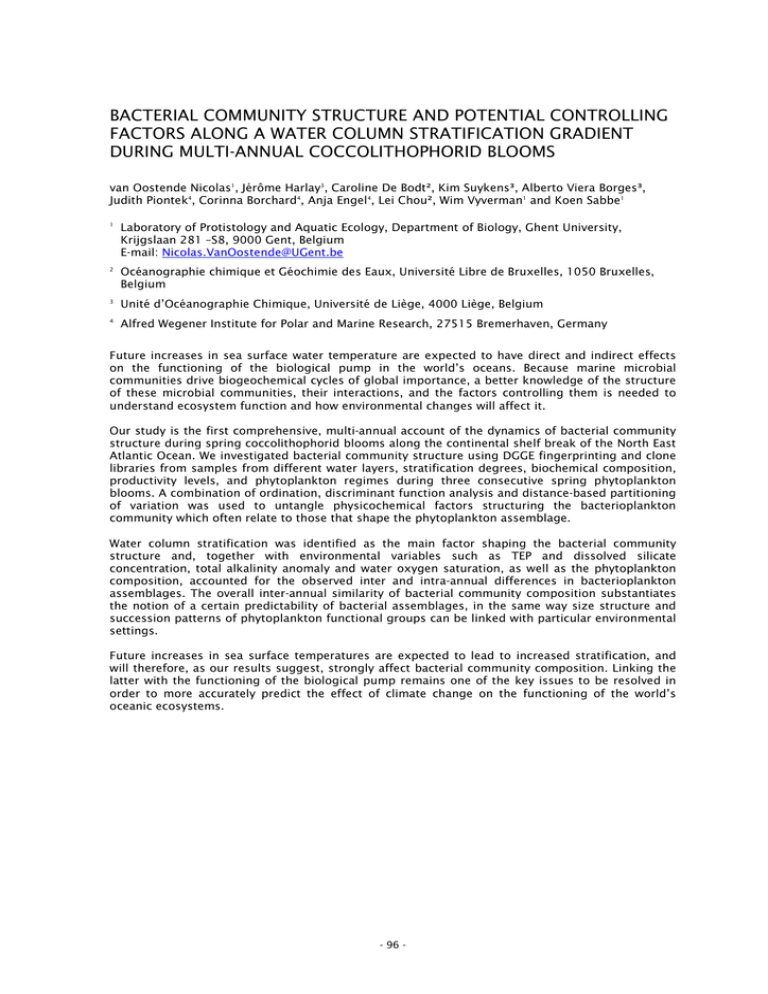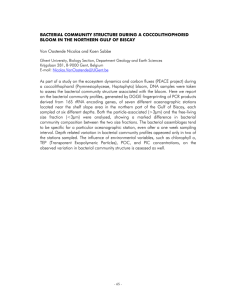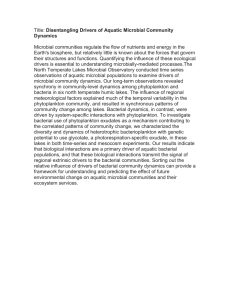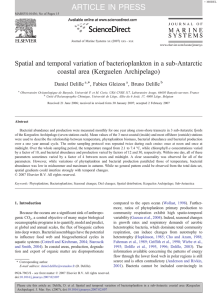BACTERIAL COMMUNITY STRUCTURE AND POTENTIAL CONTROLLING
advertisement

BACTERIAL COMMUNITY STRUCTURE AND POTENTIAL CONTROLLING FACTORS ALONG A WATER COLUMN STRATIFICATION GRADIENT DURING MULTI-ANNUAL COCCOLITHOPHORID BLOOMS van Oostende Nicolas1, Jérôme Harlay3, Caroline De Bodt², Kim Suykens³, Alberto Viera Borges³, Judith Piontek4, Corinna Borchard4, Anja Engel4, Lei Chou², Wim Vyverman1 and Koen Sabbe1 1 Laboratory of Protistology and Aquatic Ecology, Department of Biology, Ghent University, Krijgslaan 281 –S8, 9000 Gent, Belgium E-mail: Nicolas.VanOostende@UGent.be 2 Océanographie chimique et Géochimie des Eaux, Université Libre de Bruxelles, 1050 Bruxelles, Belgium 3 Unité d’Océanographie Chimique, Université de Liège, 4000 Liège, Belgium 4 Alfred Wegener Institute for Polar and Marine Research, 27515 Bremerhaven, Germany Future increases in sea surface water temperature are expected to have direct and indirect effects on the functioning of the biological pump in the world’s oceans. Because marine microbial communities drive biogeochemical cycles of global importance, a better knowledge of the structure of these microbial communities, their interactions, and the factors controlling them is needed to understand ecosystem function and how environmental changes will affect it. Our study is the first comprehensive, multi-annual account of the dynamics of bacterial community structure during spring coccolithophorid blooms along the continental shelf break of the North East Atlantic Ocean. We investigated bacterial community structure using DGGE fingerprinting and clone libraries from samples from different water layers, stratification degrees, biochemical composition, productivity levels, and phytoplankton regimes during three consecutive spring phytoplankton blooms. A combination of ordination, discriminant function analysis and distance-based partitioning of variation was used to untangle physicochemical factors structuring the bacterioplankton community which often relate to those that shape the phytoplankton assemblage. Water column stratification was identified as the main factor shaping the bacterial community structure and, together with environmental variables such as TEP and dissolved silicate concentration, total alkalinity anomaly and water oxygen saturation, as well as the phytoplankton composition, accounted for the observed inter and intra-annual differences in bacterioplankton assemblages. The overall inter-annual similarity of bacterial community composition substantiates the notion of a certain predictability of bacterial assemblages, in the same way size structure and succession patterns of phytoplankton functional groups can be linked with particular environmental settings. Future increases in sea surface temperatures are expected to lead to increased stratification, and will therefore, as our results suggest, strongly affect bacterial community composition. Linking the latter with the functioning of the biological pump remains one of the key issues to be resolved in order to more accurately predict the effect of climate change on the functioning of the world’s oceanic ecosystems. - 96 -










